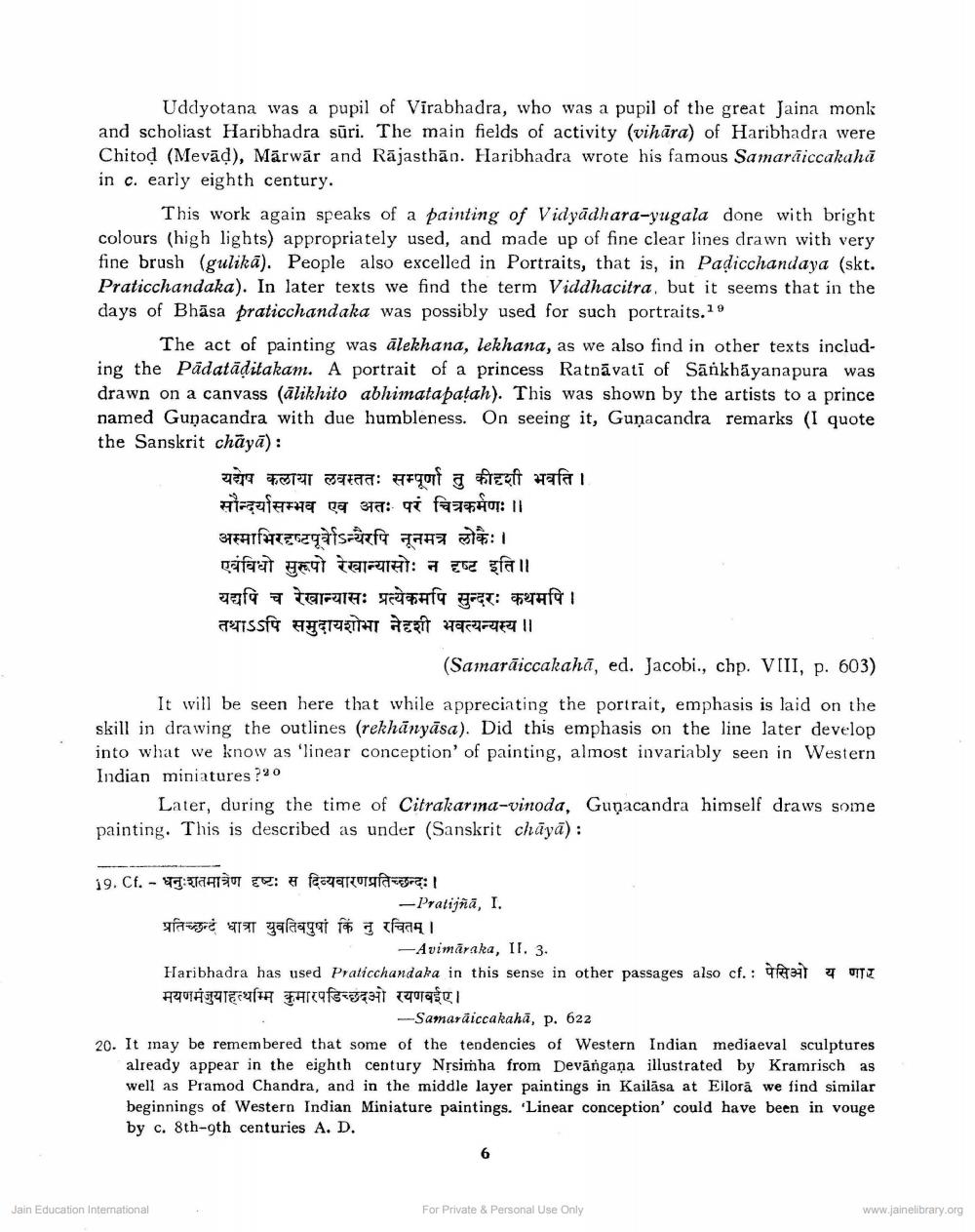________________
Uddyotana was a pupil of Virabhadra, who was a pupil of the great Jaina monk and scholiast Haribhadra sūri. The main fields of activity (vihara) of Haribhadra were Chitod (Mevad), Marwar and Rajasthan. Haribhadra wrote his famous Samarāiccahakā in c. early eighth century.
This work again speaks of a painting of Vidyadhara-yugala done with bright. colours (high lights) appropriately used, and made up of fine clear lines drawn with very fine brush (gulika). People also excelled in Portraits, that is, in Padicchandaya (skt. Praticchandaka). In later texts we find the term Viddhacitra, but it seems that in the days of Bhasa praticchandaka was possibly used for such portraits.1"
The act of painting was alekhana, lekhana, as we also find in other texts including the Pädatädilakam. A portrait of a princess Ratnavati of Sankhayanapura was drawn on a canvass (alikhito abhimatapaṭah). This was shown by the artists to a prince named Gupacandra with due humbleness. On seeing it, Gunacandra remarks (I quote the Sanskrit chaya):
यथे कलाया वस्ततः सम्पूर्णा तु कीदृशी भवति । सौन्दर्यासम्भव एव अतः परं चित्रकर्मणः || अस्माभिरदृष्टपूर्वोऽथैरपि नूनमत्र लोके । एवंविधो सुरूप रेखान्यासोः न दृष्ट इति ॥ यद्यपि च रेखान्यासः प्रत्येकमपि सुन्दरः कथमपि । तथाऽऽपि समुदायशोभा नेदृशी भवत्यन्यस्य ॥
(Samaraiccakahd, ed. Jacobi., chp. VIII, p. 603)
It will be seen here that while appreciating the portrait, emphasis is laid on the skill in drawing the outlines (rekhanyasa). Did this emphasis on the line later develop into what we know as 'linear conception' of painting, almost invariably seen in Western Indian miniatures ?20
Later, during the time of Citrakarma-vinoda, Gupacandra himself draws some painting. This is described as under (Sanskrit chayd):
19. Cf. - धनुःशतमात्रेण दृष्टः स दिव्यवारणप्रतिच्छन्दः ।
Jain Education International
-Pratija, L प्रतिच्छन् धात्रा युवति किं तु रचितम् ।
-Avimāraka, II. 3.
Haribhadra has used Praticchandaka in this sense in other passages also cf.: मयणमंजुयात्थम्मि कुमारपच्छिदओ रयणबईए।
-Samaraiccakaha, p. 622
20. It may be remembered that some of the tendencies of Western Indian mediaeval sculptures already appear in the eighth century Nrsimha from Devangana illustrated by Kramrisch as well as Pramod Chandra, and in the middle layer paintings in Kailasa at Ellora we find similar beginnings of Western Indian Miniature paintings. 'Linear conception' could have been in vouge by c. 8th-9th centuries A. D.
6
For Private & Personal Use Only
www.jainelibrary.org




